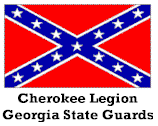The War Between the States
A Work in Progress
First, let us dispose of the
revisionism associated with the name of the late unpleasantness. It was not
a civil war. No more so than the American Revolution was a civil
war. A civil war is a conflict in which citizens of the same country
divide into camps and attempt to seize control of the body politic with the
express intent to force their will on the other side, all the while remaining
one country. Examples of true civil wars include the English Civil War,
the Glorious Rebellion of 1688, and the French Revolution. In both the
American Revolution and the War for Southern Independence, bodies of citizens
declared themselves independent, left the established government and,
consequently, fought a foreign power for their liberty. In both cases, the
established government denied the right of citizens to create this schism.
In the former case, the separatists won; in the latter they did not.
Therein lies the difference. It is a matter of public record that the
'official' name of the conflict is The War Between the States. In the
nineteenth and early twentieth century, Congress was faced with having to
frequently refer in official documents to the War agreed to Resolutions
that the name would be the 'War Between the States'.
A Few Things You May Find
Useful or Enjoy

The Cherokee Legion was a militia troop mustered from the men and boys of
greater Cherokee County, Georgia, in 1863. Their intended purpose was to
provide services such as guarding railroads and roads. They served for
only a few months and saw no organized combat. However, they did
serve and their service qualifies their male descendants for membership in the
Sons of Confederate Veterans. This link will take you to the roster of the
Legion. As an aside, the Cherokee Legion was not associated in any
official way with the members of the Cherokee Nation who gallantly served the
Confederacy.
********
The
Diary of Julius Lafayette Dowda, 3rd Georgia Cavalry, Co.F
This document is a remembrance, part diary, part
recollection, of service with the 3rd Georgia Cavalary.
Unfortunately, it contains no names but is an excellent source for the movements
of the unit. Some comments on the skirmishes and everyday type of actions
is included.
Songs and Readings
*This
speech and the music is
from The Confederacy an LP produced in the mid 1950's (Columbia Records
BL-220, which seems to be out-of-print). The music was compiled and directed by Richard Horner Bales
(1915-1998). Performers included the National Gallery Orchestra and the Cantata
Choir of the Lutheran Church of the
Reformation, Washington, D.C.
********
You may need Windows Media Player to hear this.
While Dixie's Land was the best known of the 'Confederate' songs, the
honor of being the national anthem was reserved for God Save the South composed
in 1861 by Earnest Halprin and Charles Ellerbrock. The
lyrics to the eight stanzas may be found here
This rendition for solo trumpet is found on Homespun Songs of the C.S.A.,
Volume 1 (Bobby Horton, 1985). Copies are available from, among other
sources, Dixie General Store.

